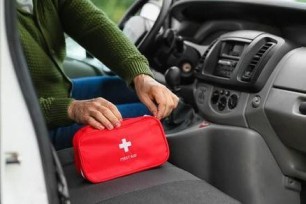General Insurance Blogs, Articles & Updates by - Magma HDI
Have us call you
- RENEW YOUR POLICY
- BUY NEW POLICY

Here are a few effective ways to heal injuries faster
In traversing through a fast-paced life, accidents are bound to occur. You might skip a step while rushing down to get your cab or cut your finger while chopping up vegetables, or simply fall and injure yourself while playing your favourite sport. Ideally, we would all want to lead a life without injuries and worry about medicines and post-care. But as someone has rightly said, "Falling is part of life, getting up is living." So, we're here to help you heal your injuries without burning a hole in your pocket.
Medical care costs are skyrocketing, and it is always the best option to get individual personal accident insurance to ensure the best coverage for severe injuries. But, for instant relief from minor injuries, you may focus on aiding the process of recovery and healing yourself faster. So, let's look into it to make our healing process quicker.
1. RICE:
RICE is an acronym for REST, ICE, COMPRESSION, ELEVATION. It is used for mild sports injuries. As the names suggest, one should give ample rest to the affected area, keep applying ice packs, and use a medical bandage for compression. Keeping the affected area elevated above the heart's level is suggested to reduce pain and swelling.
2. Eat the right food:
Certain food items possess the ability to catalyze the healing process. For example, protein-rich food like eggs, meat, cottage cheese, and citrus fruits like oranges have anti-inflammatory properties and help build ruptured tissues.
3. Wash the affected area:
In case of open injuries, washing the wound with clean water and cleaning the area with saline solutions is suggested to avoid the accumulation of bacteria.
4. Anti-bacterial ointment can do wonders:
Getting the wound examined by the doctor and applying a prescribed ointment to open wounds is highly suggested as it prevents infections and helps in faster healing.
5. Turmeric paste:
This golden formula from grandma's corner is a no-fail solution to any wound. Turmeric has anti-bacterial, anti-fungal, and anti-inflammatory properties. In addition, the curcumin present stimulates growth and helps faster restoration of the wounded area.
6. Apply pressure in case of blood loss:
It is suggested that in case of blood loss, one should maintain pressure in the affected area to avoid anaemia and ensure a faster recovery. Excessive blood loss can be a life-threatening condition. If the bleeding persists, one should see a doctor at the earliest.
7. Stitches or staples:
If the wounds are deep, it is essential to go to the doctor and get stitches or staples. Leaving them open for a prolonged time may hinder the growth of new blood vessels and prevent the wound from closing. While these procedures can be expensive, you can rest easy if covered by individual personal accident insurance.
So these are a few ways that can help you in your journey to healing yourself faster and getting back in the game. Your body is a temple, and giving it proper rest and care after injuries will help you regain your former strength sooner than you think. It is always suggested that you go to a doctor and get your injuries examined, but these remedies can help if they aren't significant.
Click HERE to get details about the different individual personal accident insurances.
Disclaimer: The information provided above is for illustrative purposes only. To get more details, please refer to policy wordings and prospectus before purchasing a policy.

The best reasons to opt for sports bikes for touring and adventure
A sports bike provides riders with an exhilarating and adventurous experience. Several high-quality sporty bikes have recently entered the market, each with its own unique set of features. In addition, sports bikes have a more upright riding position, long travel suspension, and bigger tank capacity.
Long travel suspension contributes to optimal ground clearance, allowing smoother driving over rugged terrain, which makes it possible for motorcyclists to travel into distant locations with ease. Potholes and roadblocks are no match for their speed and agility.
The following are the ultimate five reasons you should ride a sportbike for touring.
1. Customisation:
A sports bike is more convenient than a regular bike when it comes to touring. Buyers can improve the quality and crash safety of their bikes with the help of after-sale services. Every accessory is protected against rain, snow, and hail with an all-weather coating for added durability.
Helmets and riding clothes can be made just for you. It assists you in planning your outfits for road trips and prepares you for outdoor adventures. By your requirements and the location of the destination, you can select from a variety of tire options available in the market.
2. Enhanced convenience:
Seating comfort is crucial for every motorcycle rider, and many sports bikes offer it. In addition to traction control, an anti-lock braking system and several temperature riding modes make sports bikes equipped with exclusive features that assure riders' convenience. Furthermore, it provides several other technologies that make riding a motorcycle safe and enjoyable for long journeys.
The bikes are developed with practical features such as cruise control and heated seats for added comfort.
3. Serviceability and dependability:
Sportbikes are relatively simple to maintain and repair. The reduced bodywork makes routine maintenance, inspections, engine cleaning, and other vital components easier.
Because these bikes are engineered to withstand gruelling conditions for an extended time, their parts and materials are overbuilt for most types of travel. More than any other bike, their durability quotient is high. They are more powerful and torquey in technology, with designs that are fashionable.
4. Touring experience:
Touring is about more than just your vehicle. It is also essential to have a positive experience. You will undoubtedly meet and engage with other riders. Also, sports bikes have a reputation for igniting conversation with curious locals about your origins and destination.
You get to participate in many chats that will leave you with a slew of pleasant memories. A growing number of individuals are developing an interest in sports bikes. Keep an eye out for activities in your area, and don't be hesitant to drop over with your camping gear if you see one.
5. Greater fuel storage capacity:
It is common for sports bikes to have a bigger tank capacity, between 13 and 20 litres. A larger tank equates to a more excellent range of operation. In addition, it eliminates the need for numerous stops for refuelling when travelling long distances. The fact that petrol stations are far and few when you are travelling makes this feature all the more crucial for your trip!
In a nutshell, sports bikes make it possible to cover vast distances with ease, unmatched speed, and durability. It is well worth purchasing for any lengthy journey because of its design and comfort. Feel the seamless power of the engine revving your heart and exciting the rider in you.
If you have a passion for travelling on two wheels, then a sportbike can help you live your passion to the fullest. However, apart from the fun, you need to prioritise your safety while riding such powerful machines. Ride with proper safety gear and invest in 2 wheeler insurance to safeguard your finances against any damages.
Click HERE to purchase the best 2 wheeler insurance for your sports bike.
Disclaimer: The information provided above is for illustrative purposes only. To get more details, please refer to policy wordings and prospectus before purchasing a policy.

Practicing farming can have a positive impact on your life. Know how
India is an agricultural-based country, where farmers and farming have an exponential impact on the whole country. The concept of farming should not just be confined to the villages or rural areas. Rather than perceiving it as a profession, it should be practiced as a hobby that can offer several valuable experiences.
Have you thought of maintaining your own farm? This thought might have crossed your mind at least once, but you might be wondering how farming can be helpful to you. It might sound surprising to most city dwellers, but yes, farming in your backyard, lawn, or terrace can positively impact our lives. Let's know-how.
1. Creates multiple opportunities:
The farming sector is booming with many promising job opportunities. The growing demand for education and significant research in the farming sector brings many new opportunities, such as farms, nurseries, and hatcheries.
2. Maintain the economy:
The increasing population can meet the rising job opportunities in the farming sector. This ensures that the demand and supply balance is maintained. As a result, the prices of food and other products stay level for the consumers.
3. Teaches emotional investment:
Growing a crop is what nurturing a child feels like. You sow the seeds at the earliest stage and make sure they grow properly. You provide all the other nutrients and protect the seeds and saplings against harsh wind, heavy rain, and excessive sunlight. You choose suitable pesticides to ensure that the bugs and other insects don't destroy your crops. The whole cultivation process requires a lot of capital, physical labour, and emotional investment. Patience plays a huge role here. Understanding how emotions develop throughout the entire growth helps in the long run.
4. Medicinal purposes:
Many crops and plants act as medicines rich in various nutrients and minerals. Several medical practitioners advise their patients to consume the processed version of these plants (or even raw) to treat nausea, morning sickness during pregnancy, kidney stones, etc. Many of these crops are cultivated to feed the cattle and livestock and get the best quality of dairy products.
5. Saves water and soil:
The roots of the crops hold the soil tightly, thus avoiding soil erosion due to severe climatic factors like heavy rain or wind. This helps keep the nutritional value of the top layer of the soil, which is essential for the growth of plants. Practicing farming also helps avoid the drainage of toxic chemicals into the rivers or seepage into the water table.
4. Self-assurance:
It will help if you build a strong anti-nausea mindset. Keep reciting to yourself that you will not feel sick or nauseous. This prepares your brain to think flying is normal and there is no need to fear. You will gain confidence and reassure your body to stay calm, especially during stressful moments. Ask a friend or travel companion to help you when you feel nauseous.
6. Sustainability:
Farming crops that provide biodegradable products like cotton, paper, wool, etc., contribute immensely to sustainability. Due to the excessive pollution and increased usage of non-biodegradable products, there is a massive negative impact on the climatic conditions. Sustainability is a huge influencing factor in saving our planet against significant issues like global warming and climate change.
Those were some of the pointers on how practicing farming can significantly impact your life. Farming connects you directly to the soil, and the moment you feel the soil, you reap good outcomes. This sublime connection will leave a positive impression and bring out the best version of yourself.
Your contribution through farming does not mean just growing crops. It highlights your contribution to boosting the economy, promoting sustainability, and encouraging healthy living. Farming enables access to a variety of healthy food products, which help in building strength and immunity in people of all age groups. And with global health standards getting a massive blow, it becomes more important to address health issues with seriousness.
Just like you protect your precious crops from getting damaged by using the right pesticides, it is vital to safeguard your and your loved one's health. You can accomplish this by purchasing the best health insurance policy. Make a hassle-free purchase and buy health insurance online to benefit yourself with the best premium and returns on investment.
Click HERE to know more about how you can buy health insurance online.
Disclaimer: The information provided above is for illustrative purposes only. To get more details, please refer to policy wordings and prospectus before purchasing a policy.

Why a first-aid kit in your vehicle is an excellent step towards safety
Justifying the name, first-aid kit is the immediate response of medication at the time of emergency. Those initial moments can help prevent an injury from getting critical during an accident and can potentially save the life of someone on the road.
A first-aid kit in the car is essential for many situations that don't require the help of a medical professional. Most of us spend our time travelling, either for work, holiday, shopping or long drives during weekends. Unfortunately, with roads becoming more prone to accidents, the probabilities of mishappening are common.
In such situations, having a first-aid kit in your vehicle enables you to avoid severe complications until help reaches you. For the minor injuries, a first-aid kit will be a saviour to cure cuts, scratches, and other minor wounds.
The advantages include:
• Helps prevent injuries from getting worse: It is crucial to address the minor cuts or wounds developed after accidents before they turn septic. Leaving the wounds open will invite infections, and in no time, you will start feeling weak. Avoiding such situations by using first-aid is the best thing to do. Soak the cotton with antiseptic liquid and gently apply it over your wounds or scars and clean the area thoroughly. Later, use bandages to cover the wounds and let them heal at their own pace.
• The belief of being safe: Having a safety kit in the car will give you the mental satisfaction of having resources ready in case of emergencies. It makes you feel prepared to take good care of yourself even when driving solo. Another add-on to this belief is valid car insurance, which provides financial protection against any eventuality.
• Be the saviour in the crowd: If you ever witness any severe accident, having a first-aid kit will make you the first responder. You can treat and bandage the wounds to prevent excessive blood loss that can deteriorate the injured person’s health. Remember, your alertness and courage can save a life.
Must-haves in your first-aid kit:
A first-aid kit is a personal resource for emergencies, and everyone may keep them equipped with the accessories they think they may need. However, here is a checklist of some essential items that should be in your vehicle's first-aid kit.
• Cotton (swaps) and bandages
• Basic antibiotics, antibiotic cream and pain relief spray
• Hand sanitizer
• Antiseptic wipes and antiseptic liquid
• Safety pins, scissors and a tweezer
• Gloves
• Rehydration sachets
• Torch with extra batteries
• A thermometer
You must check these necessities before you pack your vehicle's first-aid kit. Additionally, ensure that you keep a list of contact numbers (family, friends, doctor, etc.) so that in case of any severe injuries, someone can reach out to your close ones and inform them about the event.
Preparedness can prevent unexpected situations from getting worse for you. Whether you are travelling alone or travelling with your friends or family, you shouldn't compromise safety. The earlier you understand the importance of having a first-aid kit in your vehicle, the better it’ll be for you.
In addition to it, for the safety of your car during mishaps, consider getting car insurance. Although having car insurance cannot prevent accidents, it can assure financial security during emergencies. As it is rightly said, "It's better to be safe than sorry". With these small precautionary measures, you can keep big troubles out of your way. So, travel safe, travel responsibly!
Click HERE to get the best insurance for your car.
Disclaimer: The information provided above is for illustrative purposes only. To get more details, please refer to policy wordings and prospectus before purchasing a policy.

Here are a few options to help you plan your budget-friendly destination wedding
In recent years, destination weddings have received increasing attention. Finding the right location to tie the knot on one of the most important days of your life is an indescribable sensation. However, these magnificent locations often drain a large portion of your funds. They may even surprise you by exceeding your wedding budget. But don't allow money to stand in the way of the total delight of tying the knot against a magnificent background that will make your wedding appear nothing short of a fantasy.
To add to this thrill without dimming your spirits with exorbitant venue expenses, we have unveiled a list of a few ideal locations. These places will make your exquisite vacation wedding planning a reality while staying on a budget!
1. Royal Jodhpur:
Jodhpur is a royal venue for you to have your destination wedding on a budget. The beautiful palaces, heritage hotels, and havelis offer you options of Royal Marwar tradition with gorgeous royal arches, domes, and wide-open courtyards. The historic buildings combined with contemporary comfort will make your wedding a day to remember. Book a multi-faceted facility with a heritage palace and a royal set-up that will provide a stunning wedding experience for your special day.
2. The Andaman and Nicobar Islands:
Imagine getting married while standing amidst an island resort with a view of the infinite ocean in front of you. It will be beyond lovely, with the waves pounding on the beach and the peaceful humming of the ocean. Your attendees will have a fantastic holiday due to your wedding and cherish every single second of it as a majestic memory to rejoice.
3. Tijara Fort, Neemrana:
Imagine getting married in a historic castle and experiencing being a royal couple. Tijara Fort is the place to go. It is perched on a high mountain with a breathtaking outlook and serenity encompassing its boundaries. It also provides a peaceful and tranquil area with a view of the mustard fields, making this destination all the more special.
4. Mussoorie:
Mussoorie is excellent for arranging a getaway wedding while staying within your budget. It is the ideal location, with a beautiful atmosphere, hypnotic mountains making a stunning background, and an abundance of flora adding to the aesthetic appeal. It also provides a wealth of facilities that will make your momentous day to cherish.
5. Jim Corbett Park:
This is recognised as one of the most aesthetically pleasing destinations in India. Surrounded by the beautiful woods and jungle, this popular tourist destination is ideal for hosting all types of wedding festivities, from pre to post-wedding. Make them stand out and distinctive, making your fantasy come true in Jim Corbett.
Over the years, the concept of big fat Indian weddings has been trending. Many couples prefer to spend extravagantly on a wedding ceremony than invest in their future planning. However, budgeting has to be beneficial in every way; for your wedding event and hereafter life. Discover the significant benefits of insurance and buy insurance policy online that suits you before starting the new phase of your life.
Click HERE to buy insurance policy online.
Disclaimer: The information provided above is for illustrative purposes only. To get more details, please refer to policy wordings and prospectus before purchasing a policy.

Best tips to help with nausea while flying
Have you ever felt nauseous and woozy during your flight’s take-off, landing, or while you are up in the air? Or have you felt an aversion to food or beverages during your air journey? If you nod your head in agreement, this condition is called motion sickness. It is a common issue among both frequent travellers and non-travellers.
Dealing with motion sickness becomes challenging for people who travel long distances or have longer durations of flights. They start feeling dizzy and tend to throw up even at the chance of slight turbulence. People with motion sickness issues experience a high level of discomfort, which makes their whole journey experience terrible to put up with.
Travelling while feeling nauseous the whole time is a nightmare. It can also be triggered by anxiety, stress, and panic. And it is very much possible to continue feeling nauseous and sick even hours after your flight. Some symptoms of motion sickness include headaches, nausea, anxiety, palm and forehead sweats, dizziness, fatigue, etc.
This blog will discuss the best tips to help with nausea or any stress during your flight.
1. Book your seat:
Make sure that you pick the right seat while booking your flight tickets. It would be great to select the seats in a stable zone and less prone to turbulence. So, the front wing of the plane is the best option for you not to feel nauseated.
2. Say no to books:
Experts suggest against reading on a plane if you experience nausea whenever you fly. To avoid feeling sick, you need to maintain equilibrium and focus on a horizontal and stable seating position. But while reading, you squint and expand your eyes to read small letters, which ruin your concentration and equilibrium.
3. Eat travel-friendly food:
Monitor the type of food you eat before you board the plane. Avoid having oily and heavy food as it will be difficult for you to digest without any movement. An excessively filled stomach can make you nauseous. Avoid salty food items that trigger dehydration. Drink lots of water to stay hydrated when high in the sky and in drier air.
4. Self-assurance:
It will help if you build a strong anti-nausea mindset. Keep reciting to yourself that you will not feel sick or nauseous. This prepares your brain to think flying is normal and there is no need to fear. You will gain confidence and reassure your body to stay calm, especially during stressful moments. Ask a friend or travel companion to help you when you feel nauseous.
Some other ways to control your nausea are by packing some medicine that aggravates sleep, drinking some ginger ale, acupressure, etc.
We hope that you found this helpful information. While we discussed the best tips to help with nausea during flight, you need to be attentive regarding your health status as well. There is no telling when you might face health distress. To make things easier in such panic health emergencies, you can rely on health insurance.
Start with your research and list all the affordable health insurance plans. Opt for the one which balances all your expectations. It is always a good idea to have a check on your safety measures before flying off or starting a trip.
Click HERE to know more about affordable health insurance plans
Disclaimer: The information provided above is for illustrative purposes only. To get more details, please refer to policy wordings and prospectus before purchasing a policy.

Complete guide to taking cross country trips
Road trips with your closest friends promise many fun memories and thrilling experiences. But have you thought of taking a cross-country road trip with your travel friends? Cross-country road trips are a fun way to explore the country's diverse and local landscapes. It also leaves space for new additions to the itinerary as you can make pit stops whenever you want to and travel at your own pace.
Planning a cross-country trip involves lots of thought and readiness in all aspects. Physical and mental preparedness is paramount when deciding to plan such extensive journeys. From budgeting to making the itinerary and ensuring the excellent condition of your bike to taking care of your health, the complete road map of your trip should be ready in advance.
In this article, we will take note of a few things to keep in mind before you take that much-awaited road trip with your friends on your bike.
1. Calculate the duration of your trip:
It is essential to calculate how much time you will need to spend on the road to the chosen destination. Depending upon the duration, you will have to decide the number of pit stops you will take and the lodging facility if you plan on halting for the night. Driving non-stop can be tiring, so chalking out the timelines for driving and resting would be an excellent way to give your body some rest.
2. Choose your stops before beginning the trip:
Doing thorough research on the entire route and marking important places to visit is an intelligent way to undertake long road trips. While choosing the places of significance, note other important things such as fuel pumps, public toilets, hygienic restaurants, etc.
3. Booking and lodging:
Booking your lodging well in advance can help you avoid the last-minute panic of finding a place to find good shelter. If you are working with a flexible schedule, look for options on the go. This will give you space for exploring newer routes, and you might stumble upon some hidden gems on the way.
4. Packing and checklist:
It is best to pack light while travelling on a two-wheeler. Since the weather can be pretty unpredictable, choosing bags with rain covers is a clever idea. Add first aid, emergency medicines, sunscreen, and snacks to your travel kit.
Another way to avoid bulky packing is to opt for vacuum packing. Vacuum packing helps in the compression of all your clothes and other essentials. This way, you save space and cut down on the number of bags you need to carry.
5. Preparing your two-wheeler:
Before taking a cross-country road trip, you must take your bike to the service centre. Check for tyre pressure, wheel alignment, brakes, engine performance, etc. Change engine oil if required. Before setting out on the journey, ensure that all your paperwork is in place. Remember to check the batteries and fill the fuel tank before you leave. Another essential thing to note is to insure your bike with 2 wheeler insurance. If you already have, consider getting add-ons such as breakdown assistance, damages due to floods, accidents etc.
A road trip can be enjoyable and one of the most exhilarating experiences if appropriately planned. Keeping a few things in mind and being responsible will add value to your experience.
As mentioned above, your health and bike are essential for your road trip to succeed. Keep a first-aid kit for common medical emergencies during your travel. Also, remember to have a comprehensive 2 wheeler insurance to ensure that your bike is covered and safeguarded against any unprecedented expense you might incur during your trip.
Click HERE to know more about 2 wheeler insurance.
Disclaimer: The information provided above is for illustrative purposes only. To get more details, please refer to policy wordings and prospectus before purchasing a policy.

Ten useful tips for finding your passion after retirement
You worked your entire life to become financially happy. But, what about your passions and dreams? Somewhere at the bottom of your heart, you wanted to pursue your passion but had to give up the dream due to the challenges of the earning days. What you were passionate about in your 20s or 30s may not be the same when you grow old.
Most adults question how they can find their passion again in their 60s or 70s. They feel that retirement is the “final point” of their life. But, as someone rightly said, “Retirement is not the end of the road; it is the beautiful start of a new journey”. Finding your passion after your retirement can be challenging, but it is not impossible. Therefore, we created a list of ten valuable tips that will make this process more accessible.
1. Avoid severe injuries:
We might think that sitting on the rear seat is safe, but that's not true. During accidents, the rear seat passenger might get badly injured. Injuries on prime parts of the body like the spine, head, abdominal can be life-threatening. To save yourself from this, make sure that you wear the seat belt correctly. Unfortunately, some cars have installed only lap seat belts, which are not entirely secure. Three-point seat belts are a better option, which have shoulder and lap belts to support the passengers' chest, shoulder, and pelvis.
2. Learning has no expiry:
Sometimes you may feel that you are not talented enough to follow your passion. However, the truth is, it is never too late to learn something new. Education has no age limit, and therefore, you can explore and learn various things through a medium that keeps you engaged and motivated.
3. Find what makes you happy:
Sometimes passion is all about things that make you happier than anything else. So, question yourself about the activities that make you truly happy or what will you regret not doing in life? Having answers to these questions can guide you towards pursuing your passion.
4. Step out of your comfort zone:
After their retirement, people feel like their lives now require a slower pace. Especially considering their age factor, people tend to think that it’s “too late” to follow their passion. Although age can play a role in physical capabilities, it does not limit your potential. You may not be as active as you were in your teenage years, but finding your passion can bring the lost joy back in your life. So, just give it a shot.
5. Recall your childhood:
Go back to the years when you were in your school or college. Put a spotlight on what you were passionate about, and then note down all the things you did as a “hobby”.
6. Take inspiration from online resources:
The Internet is a pool of free resources. Explore your options by checking out free courses online, books, shows, podcasts to keep you entertained and sane at all times.
7. Discuss with your dear ones:
Talking to your loved ones about finding your passion can help you find what’s the best for you. Your family and friends are the best advisors as they know what you love, and they can guide you on what you need to do ahead.
8. Pay attention to your thoughts:
Our mind usually dwells in our thoughts about the things we love. Pay close attention to what you think and what activities make you feel excited. Chase the feeling that inspires you to do more!
9. Take advice from a life coach:
Life coaches are experts in the field and know how to work the best in your interest. Consult the best life coach to guide you towards the next steps.
10. Prepare a list of all the activities and get working:
Lastly, prepare a to-do list to start experimenting and working on each option. You may include activities such as travel plans, world tours, settling in a farmhouse, or just a game of golf with your old mates on your bucket list.
Retirement is the start of the golden era in your life, and while it is essential to explore all the possible options, you should always prioritize your and your family’s health. Being healthy improves your overall quality of life and inspires you to pursue your passion. But, on the other hand, you won’t want your savings to blow away with all the hefty medical bills you may encounter in any unwanted situation. Therefore, make sure that you get a health insurance policy for family to live a peaceful and passionate retirement life!
Consider the positive side; investing in a good health insurance policy for family can boost your mood to experience a whole new kind of life ahead!
To know more about the health insurance policy for family, Click HERE .
Disclaimer: The information provided above is for illustrative purposes only. To get more details, please refer to policy wordings and prospectus before purchasing a policy.


